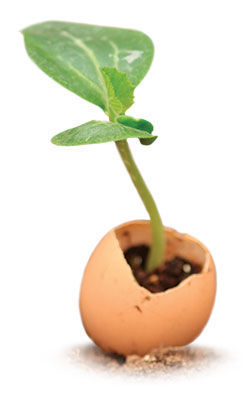
The development of a seedling is like a person waking up in the morning. There’s the dormant period (sleep). External stimuli, such as temperature and moisture, tell the seed that it’s time to break dormancy (sunrise and the alarm clock). The seed sends a root into the soil to anchor it (throwing your legs over the side of the bed). The stem and cotyledons rise upward (sitting up). The seed leaves expand (stretching your arms). And the roots and true leaves reach out for external nourishment from sunlight and water (breakfast and a cup of coffee).
4 things that make a difference
 |
 |
Plastic bagMost seeds need a humid environment to germinate. So enclose the pot in which they’ve been sown in a plastic bag to hold in moisture. Remove the bag as soon as the seeds germinate to discourage disease. |
Heat matDormant seeds also respond to warmth, telling them that it is time to wake up. The temperature in your house might be just fine, but you’ll be surprised at how much better things go with a heat mat. |
 |
 |
FanDiseases, such as the dreaded damping off, like humidity, too. Proper air circulation is the key to keeping things moist but not too moist. Letting a fan gently blow over your seedlings does the trick. |
Light standIf you are dealing with many different kinds of seeds (and their unique needs and growth rates), a light stand will help you care for them in one convenient spot. |
Good ideas:
1. Don’t go deep
Avoid planting a seed deeper than it is wide. A seed that is planted too deep will use up its stored energy before it reaches the surface.
2. Offer a light Snack
Provide a weak dose of fertilizer when the first true leaves appear to help your seedlings along.
3. Show them the light
To prevent seedlings from getting too leggy, keep them as close to the light as possible.

How to start a seed in an egg
You were going to make an omelet anyway. With a little advance planning, you can get a seed-starting container, too.
 |
 |
 |
| 1. Create a small drainage hole using a nail or ice pick. It is easier to do this before you crack the egg. | 2. Crack the shell, leaving two-thirds of the shell to form your container. Remove the contents of the egg. | 3. Plant the seed, and keep it watered. When it is time to remove the seedling, simply crush the shell to free the young plant. |
Photos: Steven Cominsky; Steven Cominsky, Brian Leavitt; Grobledo/www.dreamstime.com; Scott Phillips, Kerry Ann Moore

















Comments
Log in or create an account to post a comment.
Sign up Log in